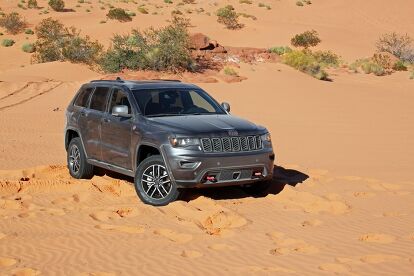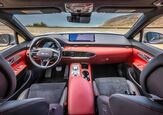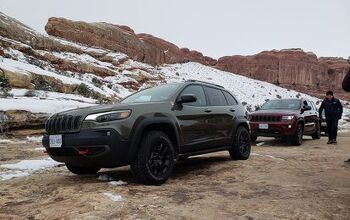2019 Jeep Grand Cherokee Trailhawk Review

Every year, the story is the same around this time of year: “prepare for winter, the snow is coming.” And we all hunker down and get our cars ready for the slippery weather. At first, the roads get covered with a fluffy pretty blanket of snow but then, it’s chaos: ice covers the roads, snow banks block paths, and plows completely forget certain roads. But dedicated drivers endure, and experience pays dividends.
But what happens when its time to face a new terrain? Drivers who face snow yearly might never tackle sand, but if the driver is smart about it, and the car is capable enough, the soft surface won’t be so intimidating. A new Jeep changed my mind about just how different snow and sand are to drive in, and yet, thanks to its confidence, I never felt unsafe or out of control.
With a 2019 Jeep Grand Cherokee Trailhawk to pilot, we set off on the sand at the Valley of Fire in Nevada, just outside of Las Vegas. The grown-up Jeep has always been a solid staple of the lineup and a car that’s easy to recommend to many buyers. The Grand Cherokee has models that start around $30,000, and that price can stretch all the way to $90,000 if you want a 707-horsepower monster. This Trailhawk starts at around $40,000 but has a few extra additions, including a 5.7-liter Hemi V8 that makes all the difference in the sand.
FAST FACTS
| Engine: | 5.7L V8 |
| Output: | 360 hp, 390 lb-ft of torque |
| Transmission: | 8-speed automatic |
| Fuel Economy (MPG): | 14 City, 22 Highway, 17 Combined |
| Fuel Economy (l/100kms): | 16.7 City, 10.9 Highway, 14.1 Combined |
| Price As Tested (USD): | $54,220 |
| Price As Tested (CAD): | $69,520 |
Driving on sand can feel a bit sluggish, like it’s bogging your tires down. That means having the extra power of the V8 over the base V6 is a huge asset. You can get going much easier, but it requires a slightly heavier foot than driving on snow. In contrast, driving in snow requires a feathery touch, so you don’t slide or skid or lose control. Sand, on the other hand, requires you to just not get stuck, and that requires a lot of throttle.
With 360 horsepower and 390 lb-ft of torque, the V8 manages to push ahead, never feeling bogged down or limited. The eight-speed automatic was clever too, not shifting too high where it couldn’t deliver the power needed to overcome the soft sand.
There’s a handy dial on the center console of the Grand Cherokee that can be used to select a terrain or road surface. On roads, it’s best to leave it in the Auto mode, but fortunately, there’s a Sand setting that adjusts the traction and stability control among other settings to allow the truck to feel more comfortable in such a setting. Naturally, it was clicked on for this drive, but we also used the air suspension to raise the ride height of the vehicle. At the highest position, the vehicle rides with 10.8 inches of ground clearance, more than two inches over the standard suspension.
This height should help to keep you from beaching the Grand Cherokee, and by extension should help protect its underbody from damage. For the most part, it works, but during the up and down action alongside some larger hills on the route we could clearly hear something making a lot of noise, most likely the rear diff banging upon the body. Slowing down and holding a steady speed helped control this situation. In past tests, on normal road conditions, the air suspension seemed like a pricey, needless gimmick. Here, it seemed a tiny bit more useful so we weren’t plowing sand dunes. The Grand Cherokee seems a tier away from the legendary Ram Power Wagon or Ford F-150 Raptor when it comes to high-speed off-roading situations.
See Also: Ram 2500 Power Wagon Review
Steering was easy to get used to. I found myself sawing at the wheel at first, constantly measuring the feedback and level of grip, but relaxed later on the trail as I became more familiar with the traction levels of the sand. My past experiences of the Grand Cherokee’s steering had me noting a bit of a numbness at center, but on the sand, the truck felt far more responsive and dialed in. It gives just enough play to ensure the car wasn’t being bullied by the surfaces being driven. It’s perfect here.
Tearing through the sand at high speeds, the Trailhawk felt confident and composed. However, there was also a large dune climb (it had to be the size of a house!) where some momentum was needed. That V8 again proved handy but so did the suspension and steering for keeping the vehicle pointed in the right direction. Bringing the car down from the dune looked intimidating, but it was so much easier from behind the steering wheel. Instead of having the rear end slide alongside you essentially making the car crab-walk down the dune, the Trailhawk managed it extremely naturally and composed.
It looked so much more intense when other drivers attacked the dune than when it was driven. Watching it happen, it looks like the truck is bouncing and wrestling with the sand, but from behind the wheel, it’s an extremely manageable situation. I wouldn’t call it serene or relaxing, but it was far less intense than it looked. It’s a somewhat out-of-this-world experience, especially when you consider that the scenery and terrain of the State Park were good enough to fill in for Mars in the 1990 film Total Recall.
See Also: 2019 Kia Sorento vs 2018 Jeep Grand Cherokee Comparison
The tougher aspects to judge were the slower speed corners on the sandy trail. Hitting the brakes causes a lot of dive, and that’s worrisome because the sand can pile up and beach the Grand Cherokee’s front end. Additionally, all that build up of sand makes slow speed turns really heavy feeling. The Jeep’s all-wheel drive helped thrust the truck through it, and it made getting through tighter spots easier, but the sand was best handled with some momentum.
One important part of this Jeep that hasn’t been mentioned yet are the tires. Standard on Trailhawk models are Goodyear All-Terrain Adventure rubber and some air was let out of them to increase the surface area and traction. This makes a huge difference, and we found the car even complaining about the low tire pressure at times, but ignored it as we soldiered on through the sand.
The Verdict: 2019 Jeep Grand Cherokee Trailhawk Review
On the surface, sand and snow aren’t very different. They’re soft conditions that can be a headache to traverse through, with the chance of getting stuck. They may typically show up on different spectrums of the temperature scale, but when you see snow or sand instead of asphalt, it’ll change how your drive is going to turn out. Vehicles like the Grand Cherokee Trailhawk are tailor-made, not for the daily commute, but for these fringe situations, where it’s confident and capable. It starts at $45,090 but can be optioned up to $57,660 if you want all the bells and whistles added. That’s a decent price for a vehicle that can do so much when the conditions change. If you’re worried about what kind of weather and roads you’ll face each week, the Jeep Grand Cherokee Trailhawk will be your best friend.
Discuss this story on our Jeep Forum.
LOVE IT
- Capable
- Great Engine
- Settings to help in Sand and Snow
LEAVE IT
- Lots of body movement

Sami has an unquenchable thirst for car knowledge and has been at AutoGuide for the past six years. He has a degree in journalism and media studies from the University of Guelph-Humber in Toronto and has won multiple journalism awards from the Automotive Journalist Association of Canada. Sami is also on the jury for the World Car Awards.
More by Sami Haj-Assaad


































































Comments
Join the conversation